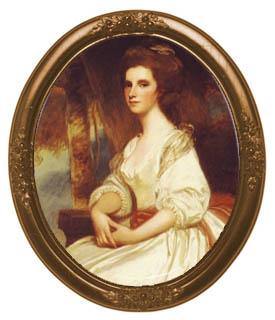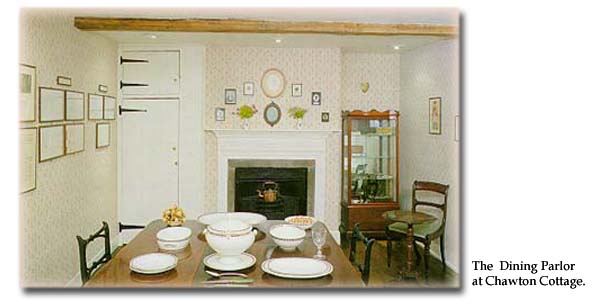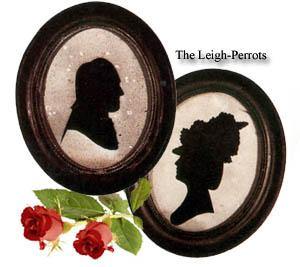
A Closer Look at Catherine Knight
I am very much obliged to Mrs. Knight for such a proof of the interest she takes in me, and she may depend upon it that I will marry Mr. Papillon, whatever may be his reluctance or my own. I owe her much more than such a trifling sacrifice.
Jane Austen to Cassandra December 9, 1808

Catherine Knatchbull Knight, the wife of Thomas Knight, is best known to Janeites as the adoptive mother of Jane Austen’s brother Edward; Edward’s inheritance of the Knight estates brought him, among other properties, the ownership of Chawton Cottage, which he was able to offer to his mother and sisters as a home, and in which Jane wrote and revised her novels for publication.
Most biographies do not see her as a great influence on Jane Austen’s life and writing, though she clearly took an interest in the Austen ladies and also in Jane Austen’s published writing. Mrs. Knight’s relationship to the Austen sisters makes an appearance in a letter written by Lady Knatchbull, née Fanny Knight, Edward’s eldest daughter and Jane Austen’s favorite niece, to her younger sister:
Yes my love it is very true that Aunt Jane from various circumstances was not so refined as she ought to have been from her talent, and if she had lived fifty years later she would have been in many respects more suitable to our more refined tastes. They were not rich & the people around with whom they chiefly mixed, were not at all high bred, or in short anything more than mediocre & they of course tho’ superior in mental powers & cultivation were on the same level as far as refinement goes–but I think in later life their intercourse with Mrs. Knight (who was very fond & kind to them) improved them both & Aunt Jane was too clever not to put aside all possible signs of ‘common-ness’ (if such an expression is allowable) & teach herself to be more refined at least in intercourse with people in general. Both the aunts (Cassandra and Jane) were brought up in the most complete ignorance of the World & its ways (I mean as to fashion etc.) & if it had not been for Papa’s marriage which brought them into Kent, & the kindness of Mrs. Knight, who used often to have one or other of the sisters staying with her, they would have been, tho’ not less clever and agreeable in themselves, very much below par as to good society and its ways. If you hate all this I beg yr’ pardon, but I felt it at my pen’s end & it chose to come along & speak the truth.
Leaving aside Janeites’ opinions of Lady Knatchbull’s state of mind when that letter was written, one can pull out the comments about Mrs. Knight—that she was fond of and kind to Jane and Cassandra Austen. The mentions of Mrs. Knight in Jane’s letters bear that out, and also indicate that the fondness was returned, and her kindness much appreciated.
Catherine Knatchbull married Thomas Knight II in 1779, around the time that her portrait was painted by George Romney, showing her as a beautiful and elegant woman. Two years later, her husband inherited his father’s estates, including property and houses at Godmersham, Chawton, and Steventon. Her father, the Rev. Wadham Knatchbull, was a younger son of Sir Edward Knatchbull, 4th Baronet. (Fanny Knight, Catherine’s adopted granddaughter, married Sir Edward Knatchbull, 9th Baronet, Catherine’s cousin and great- grandson of the 4th Bt.; their son, elevated to the peerage as Lord Brabourne, edited the first edition of Jane Austen’s letters, most of which were inherited by his mother and discovered after her death.)
As part of their wedding tour, the Knights visited Steventon, where they first made the acquaintance of young Edward Austen. Edward was invited to visit the Knights during his holidays, and in 1783, when it became clear that the Knights would be childless, they formally adopted the sixteen-year-old Edward as their heir, as shown in the silhouette at left (click for a larger version). According to Deirdre Le Faye, Mr. Knight is leaning on his sister’s Jane’s chair, and Mrs. Knight is the lady on the other side of the table, turned to see Mr. Austen presenting Edward. Edward remained at Steventon until 1786; the Knights then sent Edward on the Grand Tour, and he went to live with the Knights in 1790.  Mr. Knight died in 1794; three years later, Mrs. Knight turned over control of the estate to Edward, leaving only an income of £2,000 for herself and a small house called White Friars in nearby Canterbury, where she would live. When this scheme was first proposed to Edward, he protested that she could not give up so much, and refused to allow her to reduce her circumstances “to enrich us.” Mrs. Knight’s response was all generosity.
Mr. Knight died in 1794; three years later, Mrs. Knight turned over control of the estate to Edward, leaving only an income of £2,000 for herself and a small house called White Friars in nearby Canterbury, where she would live. When this scheme was first proposed to Edward, he protested that she could not give up so much, and refused to allow her to reduce her circumstances “to enrich us.” Mrs. Knight’s response was all generosity.
If anything were wanted, my dearest Edward, to confirm my resolution concerning the plan I propose executing, your letter would have that effect; it is impossible for any person to express their gratitude and affection in terms more pleasing and gratifying than you have chosen, and from the bottom of my heart I believe you to be perfectly sincere when you assure me that your happiness is best secured by seeing me in the full enjoyment of every thing that can contribute to my ease and comfort, and that happiness, my dear Edward, will be yours by acceding to my wishes. From the time that my partiality for you induced Mr. Knight to treat you as our adopted child I have felt for you the tenderness of a mother, and never have you appeared more deserving of affection than at this time; to reward your merit, therefore, and to place you in a situation where your many excellent qualities will be called forth and rendered useful to the neighbourhood, is the fondest wish of my heart. Many circumstances attached to large landed possessions, highly gratifying to a man, are entirely lost on me at present; but when I see you in the enjoyment of them, I shall, if possible, feel my gratitutde to my beloved husband redoubled, for having placed in my hands the power of bestowing happiness on one so very dear to me.While such an extent of generosity could not be duplicated for every member of the Austen family, Mrs. Knight, as Fanny wrote, took a kind interest in the Austen ladies, especially after Mr. Austen’s death; but as early as 1791, Mrs. Knight seemed to be showing an interest in Jane’s intellect at least, if not also in her juvenile writing. In her parodic History of England, Jane defends Mary, Queen of Scots:
Oh! what must this bewitching Princess whose only freind was then the Duke of Norfolk, and whose only ones are now Mr. Whitaker, Mrs. Lefroy, Mrs. Knight, and myself. . . .Mr. Whitaker was the author of a book that attempts to vindicate Mary, Queen of Scots, and Mrs. Lefroy was a neighbor who was also a sort of mentor to Jane. To have Mrs. Knight mentioned in this context means that she had taken sufficient notice of young Jane Austen to have discussed history with her; kind notice indeed for an older lady to take of even a precocious young cousin. Jane Austen’s letters show the continuing attention she and Cassandra received from Mrs. Knight over the next few years. From the letter of January 7, 1807:
We are extremely glad to hear that Elizabeth is so much better, and hope you will be sensible of still further amendment in her when you return from Canterbury. Of your visit there I must now speak “incessantly”; it surprises, but pleases me more, and I consider it as a very just and honourable distinction of you, and not less to the credit of Mrs. Knight. I have no doubt of your spending your time with her most pleasantly in quiet and rational conversation, and am so far from thinking her expectations of you will be deceived, that my only fear is of your being so agreeable, so much to her taste, as to make her wish to keep you with her for ever. If that should be the case, we must remove to Canterbury, which I should not like so well as Southampton.This kindness, it seemed, extended not only to notice and visits of her younger cousins, but also to financial assistance. It seems, indeed, that “Mrs. K.” was an early patron of Jane Austen. From the letter of June 20, 1808:
…we proceeded to the White Friars, where Mrs. K. was alone in her Drawing room, as gentle & kind & friendly as usual.—She enquired after every body, especially my Mother & yourself… This morning brought me a letter from Mrs. Knight, containing the usual Fee, & all the usual Kindness. She asks me to spend a day or two with her this week, to meet Mrs. C. Knatchbull, who with her Husband comes to the W. Friars to day—& I beleive I shall go.—I have consulted Edward—& think it will be arranged for Mrs. J. A.’s going with me one morning, my staying the night, & Edward’s driving me home the next Evening.—Her very agreable present will make my circumstances quite easy. I shall reserve half for my Pelisse. . . . Mrs. Knight finished her letter with, “Give my best love to Cassandra when you write to her.” I shall like spending a day at the White Friars very much. . . . I sent my answer by them to Mrs. Knight, my double acceptance of her note & her invitation, which I wrote without much effort; for I was rich—& the Rich are always respectable, whatever be their stile of writing.From the letter of June 26, 1808:
And now I beleive I have made all the needful replys & communications; & may disport myself as I can on my Canterbury visit.—It was a very agreable visit. There was everything to make it so; Kindness, conversation, & variety, without care or cost. . .We found Mrs. Knight up and better; but early as it was—only 12 o’clock—we had scarcely taken off our bonnets before company came—Ly. Knatchbull and her mother; and after them succeeded Mrs. White, Mrs. Hughes and her two children, Mr. Moore, Harriot and Louisa, and John Bridges, with such short intervals between any as to make it a matter of wonder to me that Mrs. K. and I should ever have been ten minutes alone or have had any leisure for comfortable talk, yet we had time to say a little of everything. . . .Mrs. K. has promised to call in Castle Square; it will be about the end of July. She seems to have a prospect, however, of being in that county again in the spring for a longer period, and will spend a day with us if she is. You and I need not tell each other how glad we shall be to receive attention from, or pay it to anyone connected with, Mrs. Knight. I cannot help regretting that now, when I feel enough her equal to relish her society, I see so little of the latter.
So clearly Jane Austen felt that time spent with Mrs. Knight was more than just a duty to a kind and generous relative, but something beneficial in itself, and something to be enjoyed.

After the Austen ladies removed to Chawton Cottage, Mrs. Knight’s interest continued. In October 1809, she wrote to Fanny Knight,
I heard of the Chawton Party looking very comfortable at Breakfast, from a gentleman who was travelling by their door in a Post-chaise about ten days ago. Your account of the whole family gives me the sincerest Pleasure, and I beg you will assure them all how much I feel interested in their happiness.Apparently Mrs. Knight felt enough interest in Jane’s happiness to suggest a bit of matchmaking with the Chawton rector. From the letter of December 9, 1808:
I am very much obliged to Mrs. Knight for such a proof of the interest she takes in me, and she may depend upon it that I will marry Mr. Papillon, whatever may be his reluctance or my own. I owe her much more than such a trifling sacrifice.Mrs. Knight continued to show interest in Jane’s writing career, and unlike some of the younger members of the family was admitted to the secret of her authorship, as she asked Cassandra about the progress of the publication of Sense and Sensibility. From the letter of April 26, 1811:
No, indeed, I am never too busy to think of S&S. I can no more forget it, than a mother can forget her sucking child; & I am much obliged to you for your inquiries. I have had two sheets to correct, but the last only brings us to W.(illoughby)’s first appearance. Mrs. K. regrets in the most flattering manner that she must wait till May, but I have scarcely a hope of its being out in June. . . . I am very much gratified by Mrs. K.’s interest in it; & whatever may be the event of it as to my credit with her, sincerely wish her curiosity could be satisfied sooner than is now probable. I think she will like my Elinor, but cannot build on any thing else.
While the source material is scanty, one can build a portrait of this kind, elegant woman and her interest in the well-being and intellectual life of Jane Austen and her sister and mother.
If you would like to learn more about Jane's life and times, peruse our book shop for some great non-fiction reads.
Margaret C. Sullivan is the Editrix of AustenBlog and the author of The Jane Austen Handbook: A Sensible Yet Elegant Guide to Her World. (Quirk Books, 2007). She wishes that she, too, could have her portrait painted by George Romney. Sources: Austen-Leigh, William and Austen-Leigh, Richard Arthur, Revised and Enlarged by Deirdre Le Faye. Jane Austen: A Family Record. Boston: G.K. Hall & Co., 1989. Fergus, Jan. Jane Austen: A Literary Life. New York: St. Martin’s Press, 1991. Lane, Maggie. Jane Austen’s Family Through Five Generations. London: Robert Hale, 1984. Le Faye, Deirdre. Jane Austen (The British Library Writers’ Lives). New York: Oxford University Press, 1998. Le Faye, Deirdre, Ed. Jane Austen’s Letters (Third Edition). Oxford: Oxford University Press, 1995. The Peerage.com



Leave a comment
This site is protected by reCAPTCHA and the Google Privacy Policy and Terms of Service apply.